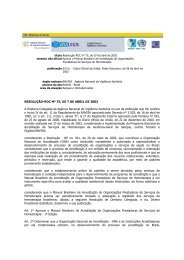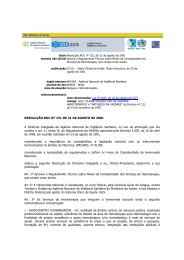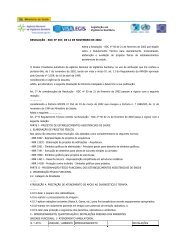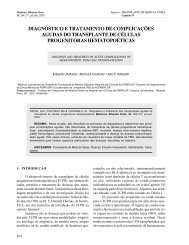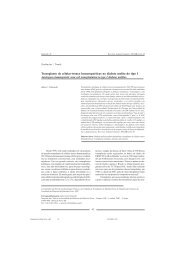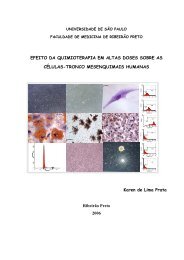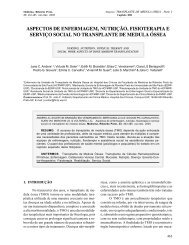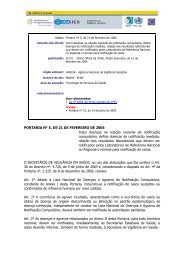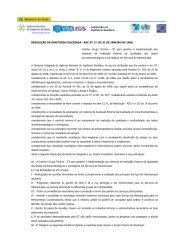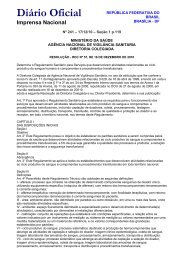Quality control of blood irradiation - ResearchGate
Quality control of blood irradiation - ResearchGate
Quality control of blood irradiation - ResearchGate
You also want an ePaper? Increase the reach of your titles
YUMPU automatically turns print PDFs into web optimized ePapers that Google loves.
GÓES ET AL.Fig. 4. Isodose curves obtained at the central plane when thephantom was irradiated with parallel-opposed fields.Fig. 6. Reduction in functional T cells, as a function <strong>of</strong> the radiationdose used, represented by a sigmoidal function.DISCUSSIONFig. 5. Percentage <strong>of</strong> viable T cells (CD3+ cells) on Day 0 assessedby flow cytometry.1:46-1:649). At 1000 cGy, the mean T-cell growth was 1 in2372 (range, 1:1056-1:4336). When cells were irradiatedwith a dose <strong>of</strong> 1500 cGy, the mean growth decreased to 1in 128,821 (range, 1:34,175–1:208,017), with T-cell growthbeing observed in all experiments. At 2000 cGy, no T-cellgrowth was observed in wells containing less than 2 × 10 6cells per well in any <strong>of</strong> the three experiments, correspondingto a reduction in the growth potential <strong>of</strong> T cells <strong>of</strong> morethan 5 log. No T-cell growth was observed in any <strong>of</strong> thethree experiments at 2500 cGy. At this dose, the meangrowth was less than 1 in 10 6 plated cells, correspondingto a reduction in the T-cell growth <strong>of</strong> more than 5.4 log.The results <strong>of</strong> T-cell inactivation as a function <strong>of</strong> the doseare summarized in Fig. 6.The prevention <strong>of</strong> TA-GVHD by the <strong>irradiation</strong> <strong>of</strong> <strong>blood</strong>components before transfusion is based on the fact that<strong>irradiation</strong> produces T-cell damage at a magnitude sufficientto inhibit their proliferative abilities and thereforetheir ability to respond to allogeneic cells. The ideal dosenecessary to prevent TA-GVHD while preserving the quality<strong>of</strong> other <strong>blood</strong> cells, excluding the lymphocytes, continuesto be an issue. A dose as little as 500 cGy canattenuate the response <strong>of</strong> lymphocytes to allogeneic cellsin a mixed lymphocyte culture, and 1500 cGy can reducethe response to mitogen-induced stimulation by 90-99 percent, representing a sensitivity lower than 2 log. 27-29In the past, based on data about the elimination <strong>of</strong> allogeneicreactivity in the mixed lymphocyte culture, the use atleast 1500 cGy was recommended. 29 Three cases <strong>of</strong> TA-GVHD have been reported in patients who received <strong>blood</strong>irradiated with doses between 1500 and 2000 cGy by use<strong>of</strong> a specific <strong>blood</strong> irradiator and a linear accelerator. 30-32Dosimetric procedures necessary to verify the dose deliveredin the <strong>blood</strong> bags, however, were not applied in thesecases.Recently, two studies with LDA assay indicated that2500 cGy was the minimal dose necessary for TA-GVHDprevention. 18,19 One <strong>of</strong> those studies tested the effects <strong>of</strong>gamma rays emitted by the 137 Cs source <strong>of</strong> a <strong>blood</strong> irradiator,and X-rays emitted by an linear accelerator, onT cells when delivered in situ to ADSOL-preserved RBCunits in PL-146 and PL-2209 plastic containers. 18 The38 TRANSFUSION Volume 46, January 2006



